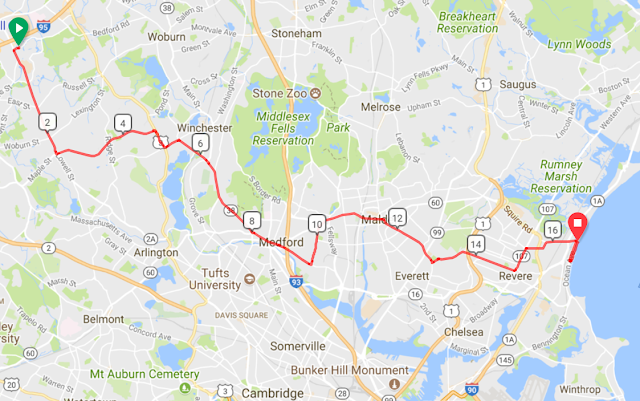Day 23 - Sunday, June 3rd - Great Bend to McPherson, KS
Distance: 64.5 miles
Elevation Gain: 852 ft. or 13.2 ft./mile
It is days like today that make cycling great. Sunny skies, light winds, with temperatures in the high 60's to low 70's, on quiet Sunday morning roads with good pavement. Simply exquisite!
It takes about 3 miles to get out of Great Bend and shortly
after we passed Fort Zarah State Park. At mile 11 we reached Ellinwood
a city of about 2100 people. The first land claim at Ellinwood was staked in 1871
when it was certain that the railroad would pass nearby. The city was named for
Colonel John Ellinwood, a civil engineer working for the railroad. In 1973 the
rock band Kansas rented the Ellinwood Opera House as a tryout show for a New
York record executive. They used free beer and a 25-cent admission price to attract
an audience. I guess it was a success.
Some pictures from the ride into Ellinwood.
The Wolf Hotel was built in 1894 by John Wolf as an addition to the Delmonico Hotel. It added several rooms along with a new lobby, underground stores and the Bank of Ellinwood. Downstairs was part of the underground tunnel system that ran under Ellinwood. I couldn't find any explanation for why the city below the city was built and the downstairs of the Wolf Hotel changed many times becoming Weber's Sample Room, the library, a gym and an underground bar and card room. The Wolf Hotel has been an antique store for the past thirty plus years. In 2013, Christopher McCord purchased the building to restore it to its' original purpose. You can still take tours of the Underground but you need to call in advance to make reservations.
Some pictures from the ride into Ellinwood.
Wolf Pond Park in Ellinwood
United Methodist Church in Ellinwood
The Historic Wolf Hotel in Ellinwood.
At mile 32 we reached Lyons,
the county seat of Rice County, Kansas and a city of about 3,700 people. Lyons
was originally named Atlanta and under that name was founded in 1870. It was
renamed to Lyons in 1876 in honor of
Freeman J. Lyons (couldn't find anything on this guy but I'm guessing he was connected to the railroad in some way) and incorporated in
1880, the year the railroad was built through it. The Dairy Queen in Lyons also happened to be the site of our only SAG stop today.
Some shots from Lyons, the epitome of a quiet Sunday morning in Middle America.
After leaving the SAG in Lyons we had another 32 miles to get to McPherson. Along the way we saw a continuation of the farmland that has become so prevalent on this portion of the tour, but it was also somewhat marred by increasing evidence of fracking activity with more gas production facilities and railroad sidings with cars built for transporting said gas.
Here are the pictures I was able to get from the ride from Lyons into McPherson.
Some shots from Lyons, the epitome of a quiet Sunday morning in Middle America.
After leaving the SAG in Lyons we had another 32 miles to get to McPherson. Along the way we saw a continuation of the farmland that has become so prevalent on this portion of the tour, but it was also somewhat marred by increasing evidence of fracking activity with more gas production facilities and railroad sidings with cars built for transporting said gas.
Here are the pictures I was able to get from the ride from Lyons into McPherson.
Definitely corn!
Gas wellheads
General McPherson
It's empty but there are no empty storefronts. It's just Sunday morning in Kansas.
Sneak Peek at Tomorrow
Abilene is the county seat of Dickinson County with a population of
just under 7,000 and home to the Dwight D. Eisenhower presidential Museum.
Abilene was originally named Mud Creek and got its start as a stage coach stop
in 1857. It was renamed Abilene in 1860 from a bible passage meaning city of
plains. In 1867, Joseph McCoy purchased 250 acres of land to the northeast of
Abilene. He built a hotel (the Drover’s Cottage), stockyards to hold 2,000 head
of cattle and stable for horses of the cowboys. The Kansas Pacific built a
railroad spur at Abilene, permitting the loading of cattle cars for shipment.
Abilene grew quickly and became the first “cow-town” of the west. McCoy encouraged Texas cattlemen to drive
their herds to his stockyards which shipped 35,000 head of cattle in 1867 and
became the largest stockyard west of Kansas City, Kansas. Wild Bill Hickok served as town marshal from
April to December 1871. While holding off a crowd in a street brawl he shot and
killed a gambler named Phil Coe who had taken two shots at him. He also
accidentally killed his deputy who was coming to his aid. The prior marshal had survived two
assassination attempts but ultimately was found murdered and decapitated in
November 1870.



























Comments
Post a Comment